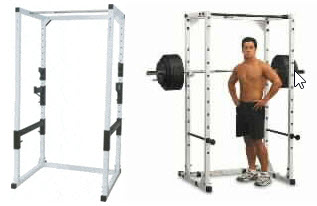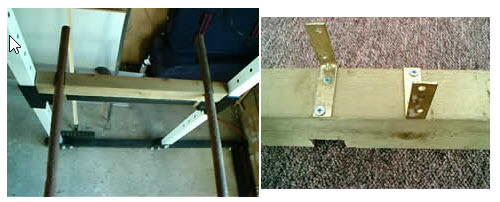By AP – MuscleTalk Member
Note: This article is predominantly for bodybuilders of a beginner’s level.Contents
Why a Home Gym could be for you
Intimidated by the bigger members of the gym? Frequently skipping workouts because travelling to the gym is too much hassle? Do you have to wait in line to use the equipment you want to? Are you constantly trying to beat your best deadlift poundage whilst the latest Westlife single blares out on the speakers?
If any of these sound like you, then leaving your gym and training at home could be the best move you ever made in order to achieve your muscular/strength goals.
There are numerous benefits to training at home, which include:
- You can use your home gym whenever is convenient to you – it is ‘open’ all day every day
- You can choose the music – no more Westlife, Will Young or Busted. You can play the music that will inspire you to lift your heaviest weights
- You can train how you want to – you do not need to be self conscious of other people
- If you want to train with your shirt off, swear and spit, you can do
There are many more advantages to training at home. One of them is cost. At a very conservative estimate, an average gym membership costs in the region of £30 ($50) a month.
So, in a year, one will be paying £360 ($600). However, with a home gym, for a one off payment of around that annual figure, a set of equipment can be bought that will last for a lifetime. Though home training may not be suitable for everyone, I for one can vouch for its effectiveness, and have not regretted the decision to start training at home once.
What Equipment You Will Need to Start a Home Gym
So, now you’ve made the decision to leave your gym and set up at home, you will need to buy the correct equipment in order to make your home gym effective. For a good home gym, the following are a necessity:
- Appropriate area of space
- Power rack
- 7ft barbell
- Cast iron weights
- Sturdy bench
- Chinning bar
- Dipping bars
- Calf block
- Pair of adjustable dumbbells
When you have some more money available, the following can be added to make the perfect home gym:
- Table for putting training log, water bottle, etc on
- Weight tree
- Thick bar
You do not need a host of fancy machines to build a quality home gym. Half of the machines you see in gyms are totally worthless anyway. Put it this way – did Ronnie Coleman build his enormous legs using the adductor machine or by performing set after set of heavy squats? Or, did Markus Ruhl build his colossal chest using the cable crossover machine or by performing set after set of heavy bench presses? I rest my case.
You should take the following points into consideration when you buy the above items:
Area of space
You do not need a big space to house your home gym, just a tidy one. A 7×10 foot space would be ideal.
Power rack

A power rack is an absolute necessity, as it provides a safe method of self-spotting for important exercises such as bench press and squat. Good power racks, such as the two shown below, can be purchased for around £200, and will be perfectly adequate.
7ft barbell and cast iron weights
You will need a standard 7-foot long barbell for use with a power rack. These can be picked up for around £20 ($35). Also, cast iron weights will be required. These again are inexpensive. Do not buy the cement filled weights found in some shops as they will crack very quickly. As a relative beginner to bodybuilding, you will need no more than 150kg to start with. Weight sets can be bought from some High Street shops or online fitness stores. It is also worth looking in your local ‘free-ad’ newspaper, as quite often, failed ‘new years resolution’ trainers are selling their unwanted weights for next to nothing.
An ideal beginner’s set of weights would include 2 x 20kg, 2 x 10kg, 8 x 5kg, 8 x 2.5kg, 4 x 1.25kg and also 4 x 0.5kg plates to allow smaller increments of weight to be made each week.
You will find 0.5kg plates in your local sports store or online. If money allows, an Olympic bar and Olympic weights would be great, but they are not necessary – standard size will do just fine.
Bench
Do not waste your time with a cheap bench which isn’t sturdy enough and will give you little confidence when you are bench pressing, etc. A good, compact bench need not be expensive, however. When buying a bench, look out for bolts. As a general rule, if the bench’s adjustment relies on bolts, the chances are it will not be strong enough. There are often some good benches being sold for very reasonable prices on eBay.
Chinning bar
The power rack will have a built on chinning bar.
Dipping bars
The power rack may also have these. It is not a problem if it doesn’t though, as a little improvisation is all that is needed. You do not need to buy an expensive dip station, though.
To make some dipping bars you will need a length of 2″ x 3″ wood, two very strong bars (acquired by any means necessary!), eight brackets (which can be bought from your local DIY superstore). Cut two lengths of wood to fit in between the uprights of your power rack.
Measure the diameter of your bars, in order to hollow out the wood so the bars can sit flush and will not move when you are dipping. Make your holes 22 inches apart. Now, fix the brackets on at either end of both pieces of wood as shown in the picture below. This will attach the pieces of wood securely to the power rack.
To use, slide the pieces of wood onto the power rack, and run the bars across. Now you have a perfectly safe and secure dipping station.

Calf block
You can improvise with this. I used a large concrete block which was ‘lying’ around unused. It needs to be 20 inches wide minimum, with a height of over 4 inches to enable you to gain a full range of motion when performing calf raisers.
If you have a slightly higher budget then you might consider buying a dedicated calf raise machine.
Adjustable dumbbells
These can be bought for very cheap – around £7-£8 ($12) from High Street stores. However, if bought from these places, they will only be 14 inches in length, which means that if you lift heavy weights then you may not be able to fit enough weight on. If this is the case, then you can buy 18-inch dumbbells from any online fitness supplier, which will, however, cost more.
Table
Again, this can be improvised. For instance, I train in my garage where there is a food freezer. The top of this provides the perfect gym table. A table is important in my view, as it is helpful to have an organised space to keep your training aids (e.g. training log, gym towel, water bottle, etc).
I have researched this greatly, comparing prices across a host of websites (mainly UK) and have come up with the following:
- Power rack – £220 ($400) (online store)
- 7ft barbell – £22 ($40) (online store)
- 110kg weight set w/dumbbells and 6ft bar – £100 ($180) (High Street store)
- Bench – £60 ($110) inc. p&p (eBay)
- Dipping bar material – £5 ($9) (DIY superstore)
Postage on the equipment from the online store would be £25 ($40), but if you could arrange to collect the equipment yourself, this expense would be saved.
So, the total cost of assembling a great home gym would be a one off payment of just over £400 ($720). Depending on what you were previously paying at your gym, the investment could well pay itself off in around a year, and then you have a set of equipment that will last for a lifetime with no more expenditure other than maybe a few more weight plates.
If you really do your homework, and manage to acquire some cheaper weights second hand, then you may be able to knock the total down even further.
Though this initial figure may seem a lot, in the long run you will make a huge saving, not forgetting the extra muscular gains you will make when training at home!
